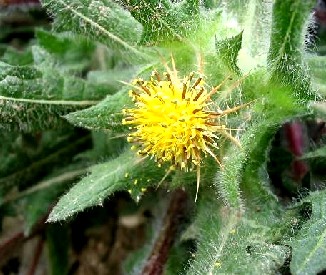
Eye Wounds and Surgery Page Menu: 1 2 3 4 5 Next>>
Eye Wounds and Surgery During the Golden Age of Piracy, Page 2
Wounded Eye Surgery
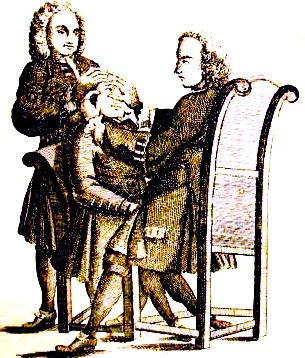
Eye Surgery Operation from
A General System of
Surgery in Three
Parts by Lorenz Heister,
Plate 17, Page 416 (1750)
There are many different ways for eyes to be wounded and it was incumbent upon the surgeon to fix such problems if he could.
Most surgeons during this time agreed that eye wounds were challenging. John Woodall, author of the popular 17th century sea-surgeon manual the surgions mate noted that "wounds of the eies are dangerous by reason of their affinity as well with the Pericranium [the external membrane that covers the skull] as the other Membrans of the braine, so that they are for the most part full of bitter paine"1.
James Handley concurs, explaining that eye wounds were difficult to cure due to "the Excellency of the Part itself"2, "the exquisite Sense [of the eye]"3, "the Consent it [the eye] hath with the Brain"4 and "the great Flux of Humors falling upon a wounded Eye"5.
Since operations of the eye were considered delicate and dangerous procedures they would probably have only been attempted at sea under the most dire necessity.
There were several different procedures used when trying to repair damaged and wounded eyes. These included pharmaceuticals made from herbal and other natural substances, various forms of humoral treatment including bleeding and purging as well as a few other procedures. Let's look at each of them.
1 John Woodall, the surgions mate, p. 146; 2 James Handley, Colloquia Chirurgica, p. 117; 3 Ibid.; 4 Ibid.;5 Ibid.
Wounded Eye Surgery - Medicines
The majority of the medical solutions to problems of the eye were non-surgical - they were medicinal. Medicine was normally the province of the Apothecaries on land, but at sea the pharmacological duties fell to the most qualified man on the ship: the surgeon. So the ship's surgeon had to be versed in medicines that were known to be useful to wounds of the eye.

John Woodall from the surgions mate
The author of the first English Sea Surgeon's manual, John Woodall, had precious little to say about eye wounds. "The medicines outwardly which I have used ever with good successe, is the artificall Balme with fine lint warme applied on the eyelids, and a Paracelsus plaster over that, and therewith I have done great cures in wounds of the eyes: but I never dropt any medicine in the eye it selfe."1 Fortunately, other surgeons were a bit more bold when discussing eye medicines and give more guidance in this direction as we shall see. However, it is interesting to note that the first sea surgeon to be published on the topic shied away from serious eye pharmacy.
One thing Woodall did mention was that the medicines should be "warme applied." This belief appears to have been widely held. No less than the master French military surgeon Ambroise Paré warned "that all such
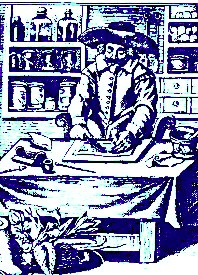
An Apothecary from The Workes of
that Famous Chirurgeon Ambroise
Parey, Frontispiece
remedies must be applied warm, both that they may the better penetrate by their moderate heat, as also for that all actuall cold things are hurtfull to the eyes and sight, because they dull the sight by incrustating the visive
[visual] spirits. For I have known many who have become dull of sight by the frequent using of medicines actually cold to the eyes. I have on the contrary seen not a few, who have recovered with the fit use of such like medicines, who have had any part of their eye (so it were not the pupilla or apple of the eye) ...pricked with a needle or bodkin, [even after] much of the waterish humor ran forth thereat."2
With this in mind, let us look at the specific medicines that were recommended during this time period. Note that all medicines were by necessity hand-made by the surgeon using herbs and other natural substances. Pharmaceuticals as we know them today did not exist. Add to this the fact that all medicinal scripts were written in oddly abbreviated and Latin and many medicinal compositions were rather complex and hard to decipher. We will look in some detail at a few of them, but for the most part we'll take a broader, less granular view of the components in eye medicines.
First we'll examine three types of medicine that were widely used by surgeons of the period. Following that, we'll look at three medicines that had popular support in various times throughout history mentioned by only one of the surgeons whose works were published during the golden age of piracy . We'll finish with some of the unusual suggestions made by Paré.
1 John Woodall, the surgions mate, p. 138; 2 Ambroise Paré, The Workes of That Famous Chirurgeon Ambroise Parey, p. 291
Collyriums
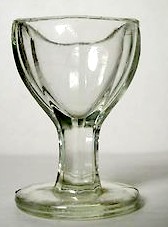
An Eye Wash Cup
The most widely advised medicines in the treatment of eyes at this time appears to have been collyriums. Unlike most of the other medicines discussed here, collyriums are not a particular herb or specific, but a generic term for an eye medicine. In one of his rare comments on eye treatment, sea surgeon John Woodall tells us "[t]he cheefe uses I have made thereof, is for Collyriums or Lotions for the infirmities of the eies, namelie, against itchings, akings, smartings, defluctions, and opthamalia's of the eies". Woodall talks about the collyrium as a lotion or wash, but it could also refer to an unguent. Period surgical authors refer to both sorts of collyrium.
Ambroise Paré gives a rather intricate prescription for a liquid collyrium "fit for clensing such wounds"2. (Note that the meaning of the Latin phrases are inserted inside square brackets. The measurements are in curly brackets and followed by i's and j's which indicate their number. This information is included for completeness - it is not recommended that the reader try to concoct any of the 300 year old recipes outlined on this web page.)
"Rx. Aquæ hordei [barley water]{ounce}j. mellis despumati [clarified honey], {dram}iij. aloes ter lot. [aloe lotion] e in aqua plantag inis [out of plantago/plantain water - plantago is an herbal remedy reputed to be astringent, anti-inflammatory, anti-histamine and styptic when applied externally.] & sacchari cand. [thermoactinomyces - a type of fungis] an {dram}j, fiat collyrium [makes the collyrium]."3
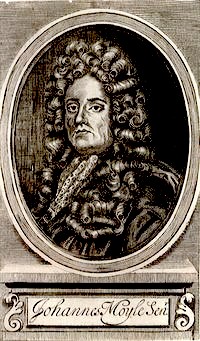
John Moyle from his book
The Sea Chirurgeon
John Moyle gives a much simpler receipt for a collyrium, telling us in his memoirs of an eye wound where "the Eye was well stuped with this Colyrium. Rx. Aq. Ros. Alb [rose water - distilled from white rose petals] {ounce}ij. Spt. Vini. Recitf. [rectified spirit distilled from wine] {ounce}i. Misce.[mixed]"4.
Moyle is also the one who gives us a recipe for some unguent versions, prefacing them by explaining that "as to Local Applications, divers kinds of Opthalmic Colyriums are used, and some agree with one persons Eyes, and some with another"5. He goes on to explain that "one of the best approved, and most used, is this: Rx. Lap. Tutiæ [Tutty (zinc oxide)] {dram}j. Aq. Ros. Alb. [rose water - distilled from white rose petals] {ounce}ij. misce, f. Colyrium [mix to create Collyrium]. When you wash your Eyes with it, shake it in the Viol, and so use it often times a day.6
He further advises the surgeon to "at Night [when the patient is] going to Bed, spread Ung. Tutiæ[Tutty (zinc oxide) ointment, an astringent paste] on pieces of Linnen cloth, and apply to the Eyes, and in the morning wash it off again with the Colyrium, which use all day, as before. This method seldom fails to Cure of inflamed Eyes, and such as are over-spread with a hot and scalding humour."7
1 John Woodall, the surgions mate, p. 284;2 Ambroise Paré, The Workes of That Famous Chirurgeon Ambroise Parey, p. 291; 3 Ibid.; 4 John Moyle, Memoirs: Of many Extraordinary Cures, p. 40;5 John Moyle, The Sea Chirurgeon, p. 247;6 Ibid.; 3 Ibid., p. 247-8
Eggs
As astonishing as it might seem today, eggs had a very large role in medicines during the time of the golden age of piracy. (So much so that they have their own article on this site.) Several of the books available to sea surgeons during this time recommend them for the treatment of non-destructive eye wounds.
Paré was a big proponent of their use in healing for many types of wounds and he suggests their use from the very beginning of his discussion of eye wounds. "[With] All strange bodies taken out, let this medicine be
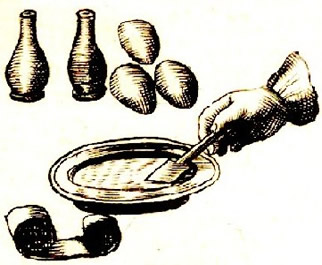
Eggs in Medicine, from The Chyrurgeons Storehouse,
by Johannes Scultetus, p. 105 (1653)
put into the eye. Take the strains of a dozen egs, let them be beaten in leaden Mortar, with a little Rose water, and so put into the eye"1. Once this is done, Paré suggests applying a repercussive [protective ointment] for which he gives a complex recipe. If the surgeon is unable to provide that, he suggests instead to "apply cheese curds well wrung, mixed with rosewater, the white of an egge, and as much
acacia [an astringent] as shall suffice."2
Paré brings the egg into the mix again later, when treating a tumor of the eye, explaining that he "dropt the following liquor into the eye, which hath a very astringent, drying and strengthening faculty [to reduce the tumor]. Roast a new laid egge in Embers until it be hard, then pull off the shel, take forth the yolk, and in place thereof put a scruple of Roman Vitrioll [Copper Sulfate] in fine powder, then put it in a linnen cloth and wring it hard forth into some clean thing, and drop thereof for some dayes into the eye, with a little Smiths water wherein Sumach and Rose leaves have been boyled. I have found by experience the certain force of this remedy"3. However, he also warns that "you must warily make use of all such things [referring mostly to the Vitriol], and alwayes lay repercussives about the eye, that no harm insue thereof. For divers times acrid humors of the eye are poured out."4
Lest you think that only one surgeon was in favor of eggs in eye medicines, another famous period military surgeon, Richard Wiseman, explained that while dressing the facial wounds of a woman he "caused some Aq. Ros. Rubr. cum Alb. Ovi [Rose-water and the whites of eggs] to be beaten together, and dropt in her Eye, a little foulded cloaths doubled and wet in the same to be laid 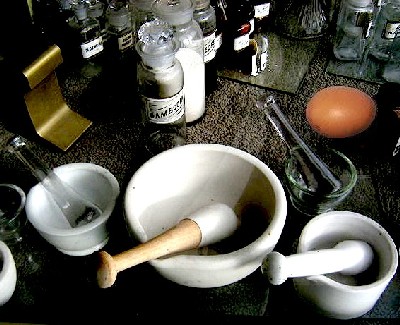
over that part, and over the [wounded] Cheek my Empl. é Bolo bolo [a plaster composed of oil, litharge (elemental lead), and bole (argillaceous earth), used as a dressing for wounded tissues.], and with Compress dipt in Oxycrate [an astringent mixture of water and vinegar], and made my Bandage over the wound, the two heads of the Roulers meeting behind"5.
Sea surgeon John Moyle also noted that while treating a "Young Girl [who] had by chance the Point of a Penknife struck into the Orbis of her Eye... [for which] there was great Pain, and it bled freely, which was obsisted by Pulv. Galeni [berberis], cum Alb. Ovi. Misce [egg whites mixed]. a Pledget being dip'd therein and applied, and a Compress dip'd in Acet. Vini. [vinegar] and expressed [the fluid pressed out], bound on it."6
Moyle also uses eggs in another capacity that is only indirectly related to eye medicines, but interesting to note. He is discussing treatment after applying a collyrium (see the detailed description below for more on collyriums):
After this I applied to it a Pledget dip'd in warm Balsam Sulphor. [Oleum Sulphuratum - described as " acrid and stimulant... but from its irritating properties must have often proved injurous... applied as a detergent [cleanser] to indolent and foul ulcers, which have ichorous or sanious discharge."7] and over that an Implaster of Diaplama [a plaster composed of palm oil, litharge [lead oxide], and zinc sulfate], pretty large to defend it, and above it about the Frons [forehead] and Temple, a defensative [protective medicine] thus: Rx. Sang Dracon. [Dragon's blood - a bright red resin obtained from various plants used wash wounds to promote healing and stop bleeding] Thur. Mastic. [a resin obtained from the mastic tree (Pistacia lentiscus) - contains antioxidents and has antibacterial and antifungal properties] Bol. Ver. Ana. [dose again] {dram}i. Ol. Ros. Acet. [acetate of rose water] Ab. Ov. [egg white] Ana Parum. Misce. [mixed in equal quantities] and over the Orbis and on the Implaster, a Compress and so made Bandage.8
1 Ambroise Paré, The Workes of That Famous Chirurgeon Ambroise Parey, p. 291; 2 Ibid.;3 Ibid., p. 292; 4 Ibid.; 5 Richard Wiseman, Of Wounds, Severall Chirurgicall Treatises, p. 57; 6 John Moyle, Memoirs: Of many Extraordinary Cures, p. 39; 7 James Rennie, A new supplement to the pharmacopoeias of London, Edinburgh, Dublin, and Paris, 3rd Ed, p. 287; 6 Moyle,p. 40
Oily Medicines
If several of the period surgeons agreed upon eggs and collyriums, several also believed that oily medicines shouldn't be used for the eyes. Surgeon James Handley warns the surgeon to "use no oily nor fat things... [because] oily things inflame the Eye, and cause Pain"1. Stephen Bradwell likewise advised that "the eye must never be dressed with any Oyle or Oyntment; because oyly and greasie things diminish the sight."2
1 James Handley, Colloquia Chirurgica, p. 117-8;2 Stephen Bradwell, Helps for Suddain Accidents Endangering Life, p. 122-3
Eye-Bright (Euphrasia) and Fennel
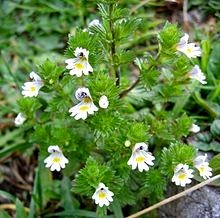
Eye-bright or Euphrasia
We now come to several remedies that appear to have had widespread support in their use on the eyes throughout history, but that
are suggested by only one of the period surgical authors whom I have read. The first is called
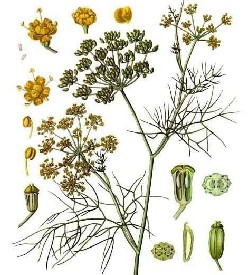
Fennel by Franz Eugen Kohler (1887)
Eye-bright or Euphrasia.
Ambroise Paré explains that the "galls [the meaning of this is not clear - galls may refer to outgrowths on the skin or the gallbladder] of Scates [skates – similar to the aquatic ray], Hares, and Partridges dissolved in Eye-bright [euphrasia – a flowering plant], and Fennill water, are fit for clensing such wounds"1.
Wikipedia tells us that fennel seeds were (and in India still are) believed to improve eyesight. "Ancient Romans regarded fennel as the herb of sight. Root extracts were often used in tonics to clear cloudy eyes. Extracts of fennel seed have been shown in animal studies to have a potential use in the treatment of glaucoma."2
1 Ambroise Paré, The Workes of That Famous Chirurgeon Ambroise Parey, p. 291-2; 2 Wikipedia, Fennel, gathered from the internet 8/5/121
Ground Ivy (Glechoma hederacea)
Stephen Bradwell tells a story of injury to a young girl's eye which is interesting enough to repeat here in full.
[S]ome Gentlemen were taking Tobacco; and as one had knocked out the snuffe or coale of it on the Table; another in jest blew it toward him, he also blew it at him againe. This began to be pursued from one to the other, till a little Girle looking on (whose height was little above the Table) received the evill of their jesting; for some of the burning coale of Tobacco was blown into her eye. It tormented her extreamely (as nothing burneth more terribly) I ran into the garden, where I found some ground Ivie, whereof I gathered some, which I stamped, and strayned, and putting a little fine powdred Sugar to the Juice, I dropped some of it into her eye; upon which she received sudden ease, and had it not applyed above twice more, before she was perfectly well: But in the meane time, her eye was muffled up from the outward ayre.1
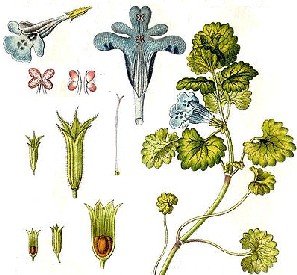
Ground Ivy by Johann Georg Sturm (1796)
In Nicholas Culpepper's The English Physician, first published in 1652, Culpepper suggests, that the "juice of celadine, field-daisies, and ground-ivy, clarified, and a little fine sugar dissolved therein, and dropped into the eyes, is a sovereign remedy for all pains, redness, and watering of them, as also for the pin and web, skins and films growing over the sight."2
Of course, no less than second century surgeon Galen of Pergamenos recommended ground ivy to treat eye inflammation.3 While 'the Ancients' were losing some of their previous esteem among period physicians, their methods were still being taught well after the golden age of piracy ended.
1 Stephen Bradwell, Helps For Suddain Accidents Endangering Life, p. 122-3; 2 Nicholas Culpepper's The English Physician, 1789 edition, p. 56; 3 Wikipedia, Glechoma hederacea, gathered from the internet 8/5/121
Blessed Thistle (Carduus benedictus or Cnicus)
Bradwell gives us another rather interesting account which mentions the use of blessed thistle in conjunction with troubles of the eye.
Blessed Thistle or Cardus benedictus Not long agoe I saw a young man stung in the eye-ball with a Bee, while he was too closely looking into the doore of the hive: But the Bee left not her sting there. Upon the place, I tooke< a handfull of Carduus benedictus [blessed thistle] newly gathered, pounded it into a morter very fine, and mixed it with the white of an egge, so spreading it upon a pledget of flaxe, I laid it to the eye, and as it waxed dry, renued it twice. < Playster of Carduus1
We again turn to Nicholas Culpepper for information. In his book, Culpepper explains that Cardus benedictus is "excellent for the head and the parts thereof... The water or juice dropped into the eyes, cureth the redness, bloodshot, and itching of them."2
1 Stephen Bradwell, Helps For Suddain Accidents Endangering Life, p. 49; 2 Nicholas Culpepper's The English Physician, 1789 edition, p. 111
Some Other, Rather Unusual Remedies
Ambroise Paré has already given us some odd concoctions for the eyes using the body parts of skates, hares and partridges. But I have saved his more bizarre recommendations for last. I'm not going to even try and explain them for you, I'm just going to let you consider them for yourself.
The milk of a woman which suckles a girl (for that is reputed the cooler) mitigates pain and clenses, if it be milked out of the Dug [teat] into the ey; to which purpose also the blood of Turtles, Pigeons or Chickens much conduces; being dropt into the eye by opening a vein under their wings…The mucilages of Psilium, or Fleawort [Herb Senecio congestus], and Quince seeds extracted in decoction of Poppy heads and mixed with a little Opium and, Rosewater, are used to asswageth pain and inflammation, and hinders defluxion [discharge of flowing humors], being applied to the eye and the adjacent parts].1
1 Ambroise Paré, The Workes of That Famous Chirurgeon Ambroise Parey, p. 291

